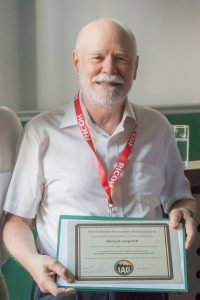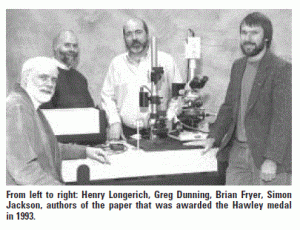 Henry was a pioneer in the application of laser ablation ICP-MS to geoanalysis. Not only did he explore and advance our understanding of the complexities of the technique itself, but he established a renowned research group, members of which have gone on to make their own major contributions.
Henry was a pioneer in the application of laser ablation ICP-MS to geoanalysis. Not only did he explore and advance our understanding of the complexities of the technique itself, but he established a renowned research group, members of which have gone on to make their own major contributions.
As we seek to probe and understand the infinite complexities of the interlocking geochemical systems of the Earth, we are immediately confronted by the fact that the geosphere is heterogeneous at all scales – from tectonic plates to mineral grain boundaries.
For much of the last century, to analyse our samples we had to either cook them up for hours or even days with very aggressive mixtures of acids, or heat them to very high temperatures with large amounts of flux, which we subsequently had to get rid of. Such destructive sample preparation techniques meant that we had to throw away – deny ourselves access to – all the vitally important spatial information that put those atoms in context.
What if we could wave a magic wand and not only set those atoms free from their cosy crystal lattices where they had slumbered for millions and even billions of years and chase them directly into our instruments so we could identify them and count them, but also know precisely – down to a few micrometres – where they had come from?
Our laser beams are that magic wand and have been used in conjunction with ICP spectrometry since the early days of ICP-AES by people such as Mike Thompson [see above] and later in ICP-MS by Alan Gray. Nowadays LA-ICP-MS is a hugely important technique used across many fields of geochemical research and beyond.
Henry had the foresight to see the potential of firstly ICP-MS, when he attended a meeting of the American Society for Mass Spectrometry in Boston in 1984. On his return, he persuaded a colleague, Dave Strong, to develop a successful application to the Natural Sciences and Engineering Research Council of Canada (NSERC) for funds to purchase a SCIEX ICP–MS instrument. Later, in 1988, he recognised the power of laser ablation for sample introduction into the ICP. Again, with NSERC funding, he purchased the components to build a Nd:YAG ablation system specifically for the in situ analysis of minerals. Crucially, these included a petrographic microscope. The observation systems of early commercial LA systems were virtually useless for geological samples.
 Henry had joined the Department of Earth Sciences at Memorial University as an assistant professor in 1978 where, for over 25 years, he plied his trade as one of the world’s premier analytical geochemists. Henry and his group systematically explored and unravelled the complex physical and chemical processes, such as elemental fractionation, that occurred as laser energy coupled to solid materials. In 1993 they were awarded the Hawley Medal of the Mineralogical Association of Canada for the best paper in their Journal in 1992 entitled The application of laser ablation microprobe-inductively coupled plasma-mass spectrometry (LAM-ICP-MS) to in situ trace element determinations in minerals.
Henry had joined the Department of Earth Sciences at Memorial University as an assistant professor in 1978 where, for over 25 years, he plied his trade as one of the world’s premier analytical geochemists. Henry and his group systematically explored and unravelled the complex physical and chemical processes, such as elemental fractionation, that occurred as laser energy coupled to solid materials. In 1993 they were awarded the Hawley Medal of the Mineralogical Association of Canada for the best paper in their Journal in 1992 entitled The application of laser ablation microprobe-inductively coupled plasma-mass spectrometry (LAM-ICP-MS) to in situ trace element determinations in minerals.
These exciting new developments encouraged young researchers from all over the world to join the MUN group. They flourished and their talents were nurtured in the atmosphere that Henry created at Memorial. Many of them, such as Simon Jackson, Paul Sylvester and Detlef Günther went on to make their own major contributions to geoanalytical science. This is something of which Henry can also be justly proud.
